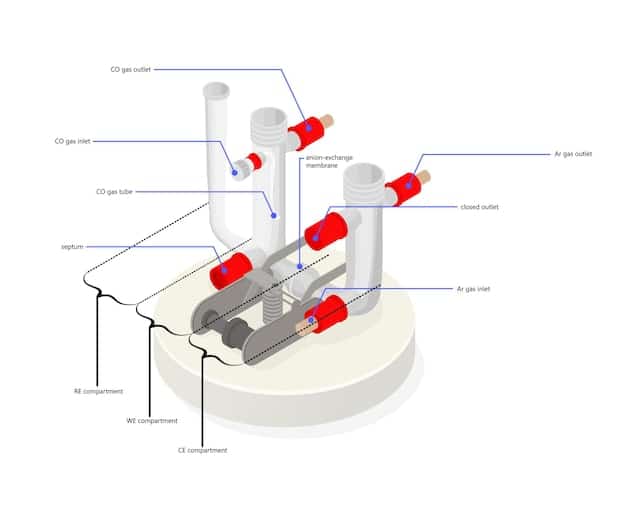Thermoelectric Energy: Latest Breakthroughs in Green Tech

Thermoelectric energy generation has seen groundbreaking advancements, including enhanced materials like skutterudites and topological insulators, improved device designs using nanotechnology, and innovative heat source integration, significantly boosting efficiency and expanding potential applications.
The quest for clean and sustainable energy sources is more urgent than ever, and what are the latest breakthroughs in thermoelectric energy generation? These innovations promise to revolutionize how we harness waste heat and convert it into usable electricity, offering solutions for everything from industrial processes to personal electronics.
Thermoelectric Energy Generation: An Overview
Thermoelectric energy generation, also known as thermoelectric power generation, is a process that converts heat energy directly into electrical energy. This technology relies on the Seebeck effect, where a temperature difference in a thermoelectric material creates a voltage, thereby generating electricity.
This method of energy conversion is gaining increasing attention due to its potential to harness waste heat from various sources, contributing to energy efficiency and sustainability. Understanding the basic principles and recent advancements in this field is crucial for anyone interested in green technology and renewable energy solutions.
The Seebeck Effect and Thermoelectric Materials
The Seebeck effect, discovered by Thomas Johann Seebeck in the 19th century, is the fundamental principle behind thermoelectric generation. It describes the phenomenon where a temperature difference (ΔT) across a thermoelectric material induces a voltage (ΔV). This voltage is directly proportional to the temperature difference, expressed as ΔV = SΔT, where S is the Seebeck coefficient.
Thermoelectric materials are essential components in thermoelectric generators. These materials must exhibit high electrical conductivity, low thermal conductivity, and a high Seebeck coefficient to achieve efficient energy conversion. The efficiency of a thermoelectric material is often quantified by its figure of merit (ZT), where ZT = (S^2σT)/κ, with σ being the electrical conductivity, T the absolute temperature, and κ the thermal conductivity.
- Bismuth Telluride (Bi2Te3): A commonly used thermoelectric material, especially effective near room temperature.
- Lead Telluride (PbTe): Known for its high-temperature performance, making it suitable for industrial waste heat recovery.
- Skutterudites: Complex materials with the potential for high ZT values, offering enhanced thermoelectric efficiency.
Advancements in materials science are continuously pushing the boundaries of thermoelectric efficiency, with ongoing research focused on enhancing the ZT values of these materials.

Latest Material Breakthroughs Enhancing Thermoelectric Efficiency
The efficiency of thermoelectric generators is highly dependent on the properties of the thermoelectric materials used. Recent breakthroughs in material science have led to the development of new materials and the enhancement of existing ones, significantly improving their thermoelectric performance.
These advancements focus on increasing the Seebeck coefficient, enhancing electrical conductivity, and reducing thermal conductivity—all crucial factors in maximizing the figure of merit (ZT) and, consequently, the overall energy conversion efficiency.
Skutterudites and Their Enhanced Properties
Skutterudites are a class of materials known for their complex crystal structures. Recent research has focused on filling the voids within these structures with various elements to scatter phonons, reducing thermal conductivity without significantly affecting electrical conductivity. This approach has led to enhanced ZT values and improved thermoelectric performance.
Researchers have successfully doped skutterudites with elements such as antimony (Sb) and germanium (Ge), creating materials with significantly reduced thermal conductivity and increased power factors. These advancements make skutterudites promising candidates for high-efficiency thermoelectric generators.
Topological Insulators: A Novel Approach
Topological insulators are materials that behave as insulators in their interior but have conducting surfaces. This unique property allows for high electrical conductivity on the surface while maintaining low thermal conductivity throughout the bulk material.
The surface states of topological insulators are protected against scattering, providing a robust channel for electron transport. This characteristic makes them ideal for thermoelectric applications, as they can efficiently convert heat into electricity with minimal energy loss. Ongoing research is exploring various topological insulator compounds and their potential in thermoelectric devices.
Nanomaterials and Quantum Dots: Scaling Down for Efficiency
The use of nanomaterials and quantum dots has opened new avenues for enhancing thermoelectric performance. Nanomaterials, such as nanowires and thin films, can exhibit different properties compared to their bulk counterparts due to quantum confinement effects.
Quantum dots, semiconductor nanocrystals that exhibit quantum mechanical properties, can be engineered to have specific energy levels, enhancing the Seebeck coefficient and improving thermoelectric efficiency. Researchers are exploring various methods to integrate nanomaterials and quantum dots into thermoelectric devices, aiming for higher power generation and energy conversion rates.
These material breakthroughs are paving the way for more efficient and cost-effective thermoelectric generators, driving the adoption of this technology in various applications.
Advancements in Thermoelectric Device Design
Beyond material advancements, innovative device designs are crucial for improving the performance and applicability of thermoelectric generators. These designs aim to optimize heat transfer, reduce energy losses, and enhance the overall efficiency of the conversion process.
By carefully engineering the architecture of thermoelectric devices, researchers can maximize the temperature gradient across the thermoelectric materials and minimize thermal shunting, leading to higher power output and improved energy conversion rates.
Micro and Nanoscale Devices
Miniaturization of thermoelectric devices has gained significant attention due to its potential in portable and wearable applications. Micro and nanoscale devices can efficiently convert heat from small temperature gradients, making them suitable for powering sensors, electronic gadgets, and biomedical implants.
These devices often incorporate thin films and nanowires, which offer enhanced thermoelectric properties compared to bulk materials. The small size and high power density of micro and nanoscale thermoelectric generators make them ideal for integration into various electronic systems.
Segmented Thermoelectric Generators
Segmented thermoelectric generators use different thermoelectric materials in series, each optimized for different temperature ranges. This approach allows for efficient energy conversion across a wide temperature gradient, maximizing the utilization of available heat.
The design involves carefully selecting and integrating materials with complementary thermoelectric properties to create a device that performs optimally over a range of temperatures. Segmented thermoelectric generators are particularly useful in applications where the heat source temperature varies significantly.
Concentrated Solar Thermoelectric Generators
Concentrated solar thermoelectric generators combine the principles of solar concentrators and thermoelectric generators to convert solar energy into electricity. These systems use lenses or mirrors to focus sunlight onto a thermoelectric generator, creating a high-temperature gradient that drives the conversion process.
By concentrating solar energy, these systems can achieve higher efficiencies compared to traditional thermoelectric generators that rely on waste heat. Concentrated solar thermoelectric generators are suitable for both small-scale and large-scale power generation, offering a sustainable alternative to conventional solar panels.
Innovative device designs are essential for unlocking the full potential of thermoelectric energy generation, enabling the development of efficient and versatile systems for a wide range of applications.

Applications of Thermoelectric Energy Generation
Thermoelectric energy generation has diverse applications across various sectors, ranging from industrial waste heat recovery to powering remote sensors and electronic devices. Its ability to convert heat directly into electricity makes it a versatile solution for energy harvesting and power generation.
The adaptability of thermoelectric generators to different heat sources and temperature gradients makes them suitable for both small-scale and large-scale applications, contributing to energy efficiency and sustainability.
Industrial Waste Heat Recovery
A significant amount of energy is wasted in industrial processes in the form of heat. Thermoelectric generators can be used to capture and convert this waste heat into usable electricity, improving energy efficiency and reducing carbon emissions.
Industries such as manufacturing, power generation, and metallurgy can benefit from implementing thermoelectric waste heat recovery systems. These systems can be tailored to fit specific industrial processes, maximizing energy savings and minimizing environmental impact.
Automotive Thermoelectric Generators
The automotive industry is exploring the use of thermoelectric generators to recover waste heat from vehicle exhaust systems. By converting exhaust heat into electricity, these generators can reduce fuel consumption and improve overall vehicle efficiency.
Automotive thermoelectric generators can be integrated into the exhaust system to capture heat and generate electricity to power vehicle accessories or charge the battery. This technology has the potential to significantly reduce the environmental footprint of the transportation sector.
Remote and Off-Grid Power Generation
Thermoelectric generators can provide reliable power in remote and off-grid locations where access to the electricity grid is limited. These generators can be powered by various heat sources, such as solar energy, biomass, or geothermal energy, making them suitable for powering remote sensors, communication equipment, and small communities.
In regions with abundant solar resources, thermoelectric generators can be combined with solar concentrators to provide continuous power generation. Similarly, in areas with geothermal activity, thermoelectric generators can harness geothermal heat to produce electricity.
From industrial applications to remote power solutions, thermoelectric energy generation offers a wide range of opportunities for improving energy efficiency and promoting sustainability.
Challenges and Future Directions
While thermoelectric energy generation holds great promise, several challenges need to be addressed to fully realize its potential. These challenges include improving material efficiency, reducing costs, and developing scalable manufacturing processes.
Overcoming these hurdles will pave the way for wider adoption of thermoelectric technologies in various applications, contributing to a more sustainable energy future.
Improving Material Efficiency
The efficiency of thermoelectric materials, as quantified by the figure of merit (ZT), remains a key challenge. Researchers are continuously exploring new materials and methods to enhance the ZT values of thermoelectric materials.
Strategies such as nanostructuring, doping, and band structure engineering are being employed to improve the Seebeck coefficient, electrical conductivity, and thermal conductivity of thermoelectric materials. These efforts aim to create materials with significantly higher ZT values, leading to more efficient energy conversion.
Reducing Costs
The cost of thermoelectric materials and devices is another significant barrier to widespread adoption. Many high-performance thermoelectric materials are made from rare or expensive elements, increasing the overall cost of thermoelectric generators.
Researchers are exploring alternative materials and manufacturing processes to reduce the cost of thermoelectric devices. This includes developing earth-abundant thermoelectric materials and implementing cost-effective fabrication techniques.
Developing Scalable Manufacturing Processes
Scaling up the manufacturing of thermoelectric devices is crucial for meeting the growing demand for energy-efficient solutions. Current manufacturing processes often involve complex and time-consuming steps, limiting the production volume.
Developing scalable and automated manufacturing processes will enable the mass production of thermoelectric generators, reducing costs and making them more accessible to a wider range of applications. This includes optimizing thin film deposition techniques, improving bonding processes, and streamlining device assembly.
Economic and Environmental Impact of Thermoelectric Energy
Thermoelectric energy generation presents significant economic and environmental benefits. By utilizing waste heat and renewable energy sources, thermoelectric generators can reduce energy consumption, lower carbon emissions, and create new economic opportunities.
The widespread adoption of thermoelectric technologies can contribute to a more sustainable and resilient energy system, benefiting both the economy and the environment.
Economic Benefits
Thermoelectric energy generation can drive economic growth by creating new jobs in manufacturing, research, and development. The deployment of thermoelectric systems in various industries can lead to energy savings, reducing operational costs and improving profitability.
The development of thermoelectric technologies can also stimulate innovation and entrepreneurship, leading to the creation of new products and services. Governments can play a role in supporting the thermoelectric industry through funding research, offering incentives for adoption, and establishing standards and regulations.
Environmental Benefits
Thermoelectric generators can significantly reduce greenhouse gas emissions by converting waste heat into usable electricity. This reduces the reliance on fossil fuels and lowers the environmental impact of energy generation.
Thermoelectric technologies can also contribute to waste reduction by utilizing heat that would otherwise be released into the environment. By capturing and converting waste heat, thermoelectric generators can help mitigate pollution and promote a cleaner, more sustainable environment.
| Key Point | Brief Description |
|---|---|
| 💡 Material Advancements | Breakthroughs in skutterudites and topological insulators are boosting efficiency. |
| ⚙️ Device Design | Microscale devices and segmented generators enhance performance. |
| 🏭 Industrial Waste Heat | Thermoelectrics recover waste heat, improving energy efficiency. |
| 🚗 Automotive Applications | Vehicles use thermoelectrics to convert exhaust heat into power. |
FAQ
Thermoelectric energy generation is the process of converting heat energy directly into electrical energy. This conversion relies on the Seebeck effect, where a temperature difference across a thermoelectric material creates a voltage.
Skutterudites are complex materials known for their unique crystal structures, which can be modified to enhance their thermoelectric properties. They are often doped with other elements to reduce thermal conductivity and improve overall efficiency.
Nanomaterials, such as nanowires and quantum dots, exhibit quantum confinement effects that can enhance the Seebeck coefficient and reduce thermal conductivity. This leads to improved thermoelectric performance compared to bulk materials.
The main challenges include improving material efficiency (ZT), reducing the cost of thermoelectric materials and devices, and developing scalable manufacturing processes to meet growing demand.
Thermoelectric energy reduces greenhouse gas emissions by converting waste heat into electricity, lessening reliance on fossil fuels. It also helps in waste reduction by utilizing heat that would otherwise be released into the environment.
Conclusion
Recent breakthroughs in materials and device designs have significantly enhanced the efficiency and applicability of thermoelectric energy generation. These advancements, coupled with growing interest in sustainable energy solutions, position thermoelectrics as a key player in future green technologies, offering diverse applications from industrial waste heat recovery to remote power generation and automotive efficiency improvements.





